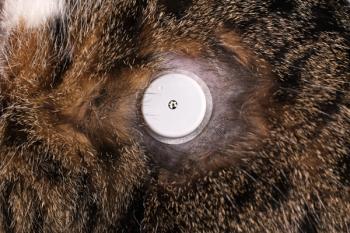
Feline hyperthyroidism 2009 (Proceedings)
Today's feline practitioners are well-versed in the pathophysiology, diagnosis, and treatment of hyperthyroidism.
Today's feline practitioners are well-versed in the pathophysiology, diagnosis, and treatment of hyperthyroidism. This disease as one of the most commonly diagnosed disorders of geriatric cats, and as our knowledge and experience in diagnosing and treating the disease have grown, certain challenges have become apparent. Treatment options for feline hyperthyroidism have not changed substantially in recent years, but awareness of adverse effects of treatment has grown, especially regarding the effects of treatment on renal function.
The Effects of Treatment on Renal Function
Several studies have shown that treatment of hyperthyroidism can have profound effects of kidney function in cats, and that feline hyperthyroidism can mask underlying chronic renal failure (Graves et al.1994, DiBartola et al. 1996; Adams et al. 1997, Becker et al. 2000). Treatment of hyperthyroidism by bilateral surgical thyroidectomy causes a consistent, and sometimes disastrous, drop in glomerular filtration rate (GFR). The same is true for radioiodine treatment. For these reasons, the wisdom of treating hyperthyroidism in cats with questionable renal function has been questioned. Especially in cats with impaired renal function, the used of methimazole seems an attractive first-line treatment for hyperthyroidism. Treatment with methimazole would be reversible in the event of exacerbation of renal failure. Furthermore, methimazole has actually been shown to have beneficial effects on kidney function in some species. However, since the effects of methimazole on renal function in hyperthyroid cats has not been studied, treatment recommendations are based on speculation. In fact, we found that methimazole consistently causes a decrease in GFR in hyperthyroid cats, and that the drop can often unmask underlying chronic renal failure (Becker et al. 2000). Fortunately, we were also able to demonstrate a reversal of this effect upon cessation of methimazole therapy. Other investigators have studied the effects of radioiodine treatment on renal function, and have found that it too causes a decline in renal function in hyperthyroid cats.
Because so many cats exhibit declining renal function upon treatment of hyperthyroidism, the currently recommended first-line treatment is methimazole, for the simple reason that it is reversible. If a cat treated with methimazole experiences a severe drop in GFR and develops overt renal failure, the clinician must begin the difficult course of balancing hyperthyroidism and its effects against the effects of renal failure. In some cases, hyperthyroidism cannot be treated at all, and the clinician must just manage weight loss, hypertension, tachycardia, and cardiac disease. In cases in which methimazole does not cause overt renal failure, owners and veterinarians can probably feel more comfortable about pursuing a more permanent treatment such as radioiodine or surgical thyroidectomy.
Methimazole Trials
In recent years, investigators have shown consistently that treatment of hyperthyroidism can have profound effects of kidney function in cats, and that feline hyperthyroidism can mask underlying chronic renal insufficiency. Post-treatment renal insufficiency is common, occurring in 17% to 38% of cats treated for hyperthyroidism. Treatment of hyperthyroidism by bilateral surgical thyroidectomy causes a consistent, and sometimes disastrous, drop in glomerular filtration rate (GFR) (Graves et al. 1994)). The same is true for radioiodine treatment and methimazole (DiBartola et al. 1996; Adams et al. 1997, Becker et al. 2000). For these reasons, the wisdom of treating hyperthyroidism in cats with questionable renal function has been questioned. Especially in cats with impaired renal function, the use of methimazole is the most logical first-line treatment for hyperthyroidism. Treatment with methimazole can be reversed in the event of exacerbation of renal insufficiency. For this reason, a trial with methimazole is recommended prior to a more permanent treatment for hyperthyroidism (Graves 1997).
Unfortunately, there are few published data to guide decisions concerning methimazole trials. Veterinarians, general practitioners and specialists alike, commonly recommend methimazole trials only for cats with questionable renal function. There is a commonly held belief that cats with well-concentrated urine (urine specific gravity > 1.035) have adequate renal function and do not run a significant risk of post-treatment renal insufficiency and that methimazole trials are not needed in these cats (Garrett 2006; Mooney 2006). There are no published data to support this opinion, and its wisdom should be questioned. First, urine specific gravity is an unreliable predictor of renal function in cats because of the diuretic effects of thyroid hormone. Second, urine specific gravity is not a measure of GFR, but rather an indicator of renal tubular function. We have asked whether hyperthyroid cats with concentrated urine actually do run a significant risk of post-treatment renal insufficiency, and have gathered preliminary data to investigate this clinical problem. We looked at 20 hyperthyroid cats developing overt renal insufficiency within 6 months of radioiodine treatment in our hospital, and compared results with 19 post-treatment cats in which overt renal failure did not develop (Riensche and Graves 2008). 10 (50%) had urine specific gravity measurements greater than 1.035. Three of those cats had urine specific gravity measurements above 1.050. We suspect, therefore, that urine specific gravity should not be used as a predictor of post-treatment renal status in hyperthyroid cats, and that a methimazole trial should be recommended for any hyperthyroid cat that can tolerate the drug.
There are no published studies that have determined the best length of time for a methimazole trial. Studies in which GFR has been measured in cats treated for hyperthyroidism have typically examined renal function before and 30 days after treatment. It is not known whether there is a further decline in GFR after this initial treatment period, or whether the decline in GFR is permanent. Our opinion is that a 30-day period is adequate, but that is based on our clinical experience rather than on scientific results. It should also be noted that a good response to a trial with methimazole does not guarantee that a given cat will not experience overt renal insufficiency with subsequent radioiodine treatment. In our hospital we have seen several cats with hyperthyroidism well-controlled on methimazole and with well-concentrated urine and normal serum creatinine and urea nitrogen concentrations, that developed overt renal insufficiency shortly after radioiodine therapy. Some have speculated that a more gradual drop in circulating thyroid hormone concentrations with anti-thyroid drugs vs. radioiodine may explain this situation. Also, methimazole may have some renal protective effects in cats as has been shown in other species.
Are there Predictors of Post-Treatment Renal Failure?
Despite the recommendation of some experts, there is no strong evidence to support the notion that cats with urine specific gravity measurements about 1.035 are not at risk for renal insufficiency following treatment of hyperthyroidism, but it is unknown whether there are other predictors. Our group has examined many cases of post-treatment renal failure looking for pre-treatment predictors, and we have not been able to find anything that can predict renal failure. Investigators have reported that pre-treatment GFR measurement may be useful as a predictor of post-treatment renal status in hyperthyroid cats (Adams et al. 1997). In one report cats that underwent treatment for hyperthyroidism and did not develop renal insufficiency all had pre-treatment GFR measurements of greater than 2.25 ml/kg/min. The authors concluded that pre-treatment GFR was a valuable predictor of post-treatment renal insufficiency. We looked back at our original published reports of GFR in cats with hyperthyroidism, and found that 3 of 5 hyperthyroid cats experiencing post-treatment renal insufficiency had pre-treatment GFR's greater than 2.5 ml/kg/min (Graves et al 1994). We found no significant difference between GFR in cats that did or did not experience post-treatment renal insufficiency. Because of these two conflicting reports, it is probably unwise to consider a given cat safe from harm if the pretreatment GFR is >2.25 ml/kg/min. Differences in methods of determining GFR may account for these disparate reports, but we do not believe there is adequate published evidence to rely on GFR measurement to predict post-treatment renal insufficiency in hyperthyroid cats. Furthermore, measurement of GFR in cats is difficult. Most accepted methods of GFR estimation are not available to the majority of small animal practitioners, so a methimazole trial would be considerably more practical.
How is a Methimazole Trial Done?
While the time necessary to see if treatment of hyperthyroidism will cause overt renal insufficiency has yet to be determined, there is adequate evidence to suggest that 30 days is a reasonable time. A common mistake, however, is failure to recheck serum thyroid hormone concentrations during the trial. Because the half-life of T4 in the cat is less than 8 hours, I typically recheck cats one week after starting a trial. If the T4 is not in the lower half of the normal range (optimal for hyperthyroidism control), the dose is increased and the on-month period is started again. Often the dose of methimazole needs to be adjusted to achieve euthyroidism, and the goal is to have euthyroidism for a month, not just methimazole for a month. Because of the danger of developing other side effects to methimazole ( eg. vomiting, hepatopathy, blood dyscrasia) cats should be re-evaluated at 2-week intervals while on a methimazole trial.
How is Post-Treatment Renal Failure Managed?
If removal of excess thyroid hormone is responsible for the decline in GFR seen in cats treated for hyperthyroidism, can post-treatment renal insufficiency be treated by giving T4 supplementation? Figures 2 and 3 show data from 5 cats with post-radioiodine renal insufficiency treated with 0.05 mg of thyroxine given orally twice daily. T4 supplementation for 30 days, as expected, reliably increased the serum concentration of T4. Body weight remained mostly unchanged. In this preliminary study, serum concentrations of creatinine did not decrease reliably, with 2 of the 5 cats experiencing increases in creatinine despite T4 supplementation. These data provide a hint that T4 supplementation in cats with post-treatment renal failure may prove clinically disappointing with expectations for increases in GFR not being met. Thorough investigation of this treatment strategy is currently underway.
Transdermal Methimazole
Recently, compounding pharmacies have offered methimazole, and a variety of other drugs for small animals, in transdermal gels. These gels contain lecithin and pluorinc ( called pleuronic lecithin organogel or PLO gel), and, until recently evidence of the effectiveness of transdermal methimazole was anecdotal. One study showed that absorption of a single dose of methimazole was poor when compared to oral or intravenous routes (Dr. Trepanier's lab at University of Wisconsin) (Hoffman et al. 2002). Investigators at Louisiana State performed a retrospective study of 13 hyperthyroid cats treated with transdermal methimazole at doses ranging from 2.5 mg once a day to 10 mg BID, and found that clinical signs improved and serum T4 concentrations decreased significantly (Hoffman et al. 2003). No adverse effects were reported in that study. Most recently another study was done (Sartor et al. 2004) which contained the most useful results to date. 44 cats were studied; 17 were treated with oral methimazole, the 27 received transdermal drug. Cats treated orally were euthyroid by 2 weeks, while cats receiving transdermal methimazole were not. There was, however, no difference in euthyroidism between two groups at 4 weeks. More GI side effects were observed in the in oral group (24% vs. 4%). The two treatment groups had equal incidence of hepatotoxicity, leukopenia, and facial excoriation.
We have a large number of feline patients at the University of Illinois being treated with transdermal methimazole. Most of these cats do well clinically, and owners seem generally pleased with this route of administration.
Frequency of Methimazole Administration
It has been a fairly common practice to administer methimazole once daily is some cats when twice daily dosing is inconvenient. Lauren Trepanier's group at the University of Wisconsin studied the efficacy and safety of giving an entire day's dose at once, and found that it was less effective in controlling hyperthyroidism than when the dose was divided BID (Trepanier et al. 2003). After two weeks of treatment, only 54% of cats receiving 5 mg methimazole once daily were euthyroid, whereas 87% of cats receiving 2.5 mg methimazole BID were euthyroid.
While once daily dosing of methimazole is not advised, carbimazole, a pro-drug that is converted to methimazole, might be a useful once daily alternative. The use of carbimazole in cats with hyperthyroidism is well-established, and a recent report (Frenais et al 2008) described a controlled release carbimazole formulation that appears effective as a once daily dose. The product is marketed as Vidalta™ in Europe, and U.S. veterinarians may well have this drug available in the future.
References
Adams WH, Daniel GB, Legendre AM, et al. Changes in renal function in cats following treatment of hyperthyroidism using 131I. Vet Radiol Ultrasound. 1997;38:231-238.
Becker TJ, Graves TK, Kruger JM, et al. Effects of methimazole on renal function in cats with hyperthyroidism. J Am Anim Hosp Assoc. 2000;36:215-223.
DiBartola SP, Broome MR, Stein BS, et al. Effect of treatment of hyperthyroidism on renal function in cats. J Am Vet Med Assoc. 1996;208:875-878.
Garrett LD, The hyperthyroid cat. NAVC Clinician's Brief 2006;4:79-82.
Graves TK. Hyperthyroidism and the kidney In: August JR, ed. Consultations in Feline Internal Medicine 3. 3rd ed. Philadelphia: WB Saunders Co, 1997;345-348.
Graves TK, Olivier NB, Nachreiner RF, Kruger JM, Walshaw R, Stickle R. Changes in renal function associated with treatment of naturally-occurring hyperthyroidism in cats. Am J Vet Res 55:1745-1749, 1994.
Hoffman SB, Yoder AR, Trepanier LA. Bioavailability of transdermal methimazole in a pluronic lecithin organogel (PLO) in healthy catJ Vet Pharmacol Ther. 2002 Jun;25(3):189-93.
Hoffmann G, Marks SL, Taboada J, Hosgood GL, Wolfsheimer KJ.
Transdermal methimazole treatment in cats with hyperthyroidism.
J Feline Med Surg. 2003 Apr;5(2):77-82.
Rayalam S, Eizenstat LD, Hoenig M, Ferguson DC. Cloning and sequencing of feline thyrotropin (fTSH): heterodimeric and yoked constructs. Domest Anim Endocrinol. 2006B;30:203-217.
Riensche MR, Graves TK, An investigation of predictors of renal failure following treatment of hyperthyroidism in cats, J Feline Med Surg 2008;10:160-166.
Sartor LL, Trepanier LA, Kroll MM, Rodan I, Challoner L. Efficacy and safety of transdermal methimazole in the treatment of cats with hyperthyroidism.
J Vet Intern Med. 2004 Sep-Oct;18(5):651-5.
Trepanier LA, Hoffman SB, Kroll M, Rodan I, Challoner L. Efficacy and safety of once versus twice daily administration of methimazole in cats with hyperthyroidism.
J Am Vet Med Assoc. 2003 Apr 1;222(7):954-8.
Newsletter
From exam room tips to practice management insights, get trusted veterinary news delivered straight to your inbox—subscribe to dvm360.




